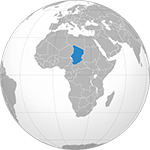Overview
Security threats around Lake Chad, most notably from Boko Haram (BH), and military operations to contain them have displaced civilians from their homes and disrupted livelihoods. Insecurity has also pushed Nigerian refugees into Chad since 2014, creating a complex displacement crisis across the islands and shores of Lake Chad. Large and protracted refugee populations, mainly from Sudan and CAR, in the south and east of the country also face significant humanitarian needs.?
IDPs and host families in the Lac region are predicted to experience Crisis (IPC Phase 3) levels of food insecurity until September, as violence and displacement affect access to markets and fishing activities. Food insecurity will affect 5.1 million people across the country during the lean season, including over 1.7 million severely food insecure due to the decrease in agricultural production and the weakness of water resources in the region. The nutritional situation remains worrying in the whole country, with an alarming state in 15 of the 23 provinces. For children under 5, global acute malnutrition (GAM) has reached the 10% alert threshold for nearly 1.9 million children.? 2 million people are in need of WASH support across the country. Only 61% of the population have access to water and 33.5% of the population is able to access clean drinking water. Basic sanitation coverage is as low as 12% and only 37.7% of the population have access to a hand washing facility with soap and water. Lack of drinking water, hygiene and sanitation infrastructure lead to the deaths of around 19,000 people each year.?
The COVID-19 pandemic has caused an 87% increase in the amount of people in need of health assistance in Chad, from 950,000 in January 2020 to nearly 1.8 million in May 2020. This is largely due to poor access to basic social services and increasing numbers of disease outbreaks. In addition to COVID-19, Chad is also facing a measles outbreak.?
Latest Developments
09/06/2022: More than 100 people were killed in clashes between gold miners in Kouri Bougoudi district (Tibesti province) over 23-24 May. At least 2,000 people fled to Zouar, Zouarké and Wour towns where incidents of human trafficking have been reported. Most urgent needs include water, food, non-food items and transport to their areas of origin.?
08/06/2022: The government of Chad declared a food emergency on 1 June. An estimated 4.1 million people will need food assistance in the June-August lean season, including some 2 million people in Crisis (Phase 3) and 100,000 in Emergency (Phase 4). Children are of particular concern, with around 1.3 million cases of acute malnutrition expected. Food insecurity levels are particularly alarming in Barh el Gazal, Batha, Guera, Hajer Lamis, Kanem, Lac, Ouaddai, Salamat, and Wadi Fira provinces. The decline in agricultural and livestock production due to climate change, intercommunal violence over access to natural resources such as water, and insecurity caused by the activity of non-state armed groups are likely to result in the country’s worst lean season of the last 10 years. The decreasing volume of local and imported food products, particularly due to the impact of the fuel shortage on transport costs and the war in Ukraine, has contributed to an increase in prices.?
Key Figures
INFORM Global Crisis Severity Index
Crisis Severity: 4.2
Impact: 4
Humanitarian Conditions: 4.4
Complexity: 4.2
Access Constraints: 4
Information courtesy of ACAPS. https://www.acaps.org/
Key Figures - 2021 HPC
in need
reached
Objectives
- Improve the living conditions and physical protection of IDPs and returnees through effective coordination of shelter actors.
- Improve the living conditions of IDPs and returnees through the distribution of emergency shelters and the construction of transitional/semi-durable/sustainable shelters or through the rental system in a nexus vision.
- Contribute to meeting the basic needs of IDP and returnee households through the distribution of essential household items in kind or in cash.
- Contribute to the resilience and self-reliance of IDPs, returnees and host communities including people living with disabilities through paid shelter work.
| Title | Posted on |
|---|---|
| Norway reaffirms its commitment to stabilization in Iraq with US$ 7.5 million contribution [… | 24 Jun 2022 |
| WFP Iraq Country Brief, May 2022 | 23 Jun 2022 |
| UN-Habitat Iraq… | 23 Jun 2022 |
| Newly Arrived Syrian Refugee Households in Bardarash Camp Bardarash District,… | 22 Jun 2022 |
| Iraq: Displacement: it is NOT ENDING… | 22 Jun 2022 |
18 Common Operating Datasets or CCCM-tagged datsets are on the Humanitarian Data Exchange:
- Chad Displacement Data - Site & Village Assessment - Lac Province - [IOM DTM] - International Organization for Migration (IOM) - [2017-08-21T00:00:00 TO 2021-12-27T23:59:59]
- Chad: Nombre de personnes déplacées internes, réfugiés et retournés par niveau admin2 et désagrégé par âge et sexe - UNHCR, IOM - [2019-09-30T00:00:00 TO 2021-11-26T23:59:59]
- Sahel Population Movement Data - Multiple sources (Humanitarian Partners) - [2012-01-01T00:00:00 TO 2021-03-29T23:59:59]
- GRID3 Chad Settlement Extents, Version 01.01 - Center for International Earth Science Information Network; Novel-T - [2021-12-21T00:00:00 TO *]
- Chad Displacement Data - Baseline Assessment - Returns - Region Moyen Chari - [IOM DTM] - International Organization for Migration (IOM) - [2019-10-02T00:00:00 TO 2019-11-13T23:59:59]
- Chad Displacement Data - Baseline Assessment - Returns - Region Logone Oriental - [IOM DTM] - International Organization for Migration (IOM) - [2019-10-02T00:00:00 TO 2019-11-12T23:59:59]
- Sahel - Subnational Administrative Boundaries - Refer to individual COD-AB datasets (linked below) - [2020-09-11T00:00:00 TO 2020-09-11T23:59:59]
- Chad Displacement Data - Baseline Assessment [IOM DTM] - International Organization for Migration (IOM) - [2017-09-01T00:00:00 TO 2021-09-30T23:59:59]

